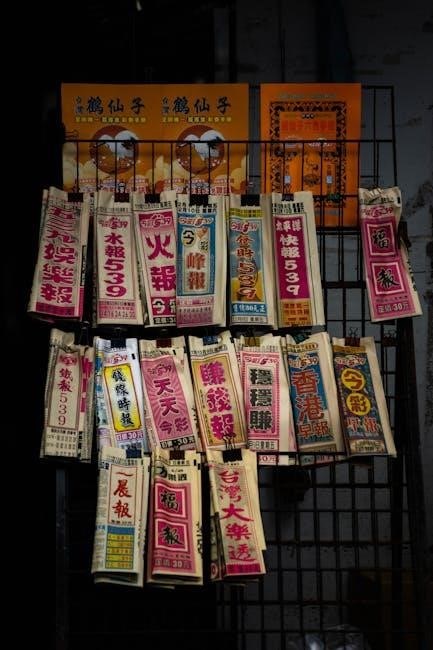Shirley Jackson’s “The Lottery” is a chilling tale exploring themes of tradition‚ brutality‚ and societal conformity․ Published in 1948‚ it shocks readers with its dark twist․
1․1 Overview of the Short Story

Shirley Jackson’s “The Lottery” is a haunting short story published in 1948․ It takes place in a small‚ rural village where an annual lottery is held․ The story unfolds on a sunny summer day‚ creating a sense of normalcy․ However‚ the lottery’s true purpose is revealed as a dark‚ inhumane tradition․ The villagers gather to draw slips of paper‚ and the “winner” faces a brutal fate․ Tessie Hutchinson‚ the protagonist‚ ultimately is chosen and stoned to death by her community․ The story’s shocking climax highlights the dangers of blind tradition and societal conformity‚ leaving readers with a lasting sense of horror and moral reflection․
1․2 Historical Context of the Story
Shirley Jackson wrote “The Lottery” in 1948‚ a period marked by post-war anxiety and societal conformity․ The story reflects the era’s underlying fears of blind tradition and collective guilt․ Drawing inspiration from folklore and mythology‚ Jackson crafted a tale that critiques the darker aspects of human nature․ The historical context also touches on gender roles‚ as Tessie Hutchinson’s fate symbolizes patriarchal oppression․ Jackson’s personal struggles with societal expectations further influenced the narrative‚ creating a timeless warning against unchecked traditions and mob mentality․ The story’s release coincided with growing scrutiny of societal norms‚ resonating with readers and sparking controversy that continues to this day․ Its historical backdrop enriches its thematic depth‚ making it a powerful commentary on human behavior and cultural practices․
1․3 Shirley Jackson’s Writing Style
Shirley Jackson’s writing style in “The Lottery” is marked by subtlety and a calm‚ almost serene tone that contrasts with the story’s dark and shocking climax․ She employs a detached narrative voice‚ creating a sense of normalcy that lulls readers into a false sense of security․ Jackson’s use of symbolism‚ particularly the lottery itself‚ adds layers of meaning‚ inviting readers to reflect on deeper societal issues․ Her ability to build suspense through everyday dialogue and descriptions heightens the story’s tension․ The ambiguity in her storytelling leaves much to interpretation‚ a hallmark of her craft․ This style not only underscores the horror of the event but also emphasizes the randomness and moral ambiguity inherent in human behavior․

Themes in “The Lottery”
The story explores societal issues like tradition‚ randomness‚ and moral ambiguity‚ using the lottery ritual as a metaphor for blindly following harmful customs․
2․1 The Power of Tradition
In “The Lottery‚” tradition is depicted as a force that binds the community‚ perpetuating a brutal ritual․ The villagers follow the lottery without questioning its origin or purpose‚ highlighting how deeply ingrained customs can override moral judgment․ The story critiques the dangers of blind adherence to tradition‚ showing how it can lead to violence and injustice․ Jackson uses the lottery as a metaphor for societal practices that are upheld simply because they have always existed‚ rather than being evaluated for their ethical implications․ This theme serves as a warning against unquestioned conformity to cultural norms․
2․2 Mob Mentality and Group Conformity
In “The Lottery‚” Shirley Jackson illustrates how mob mentality and group conformity lead to morally reprehensible actions․ The villagers collectively participate in the brutal ritual‚ turning against Tessie Hutchinson without hesitation․ This highlights how individuals abandon their moral judgment when swept up in group behavior․ The story shows how fear of social exclusion and the desire to conform can override personal ethics; Jackson critiques the dangers of unquestioned groupthink‚ as the community perpetuates violence under the guise of tradition․ The transition from a peaceful village atmosphere to a violent mob underscores the terrifying ease with which individuals lose their moral agency when part of a collective․
2․3 The Randomness of Brutality
In “The Lottery‚” Shirley Jackson explores the randomness of brutality through the story’s shocking climax․ The selection process‚ seemingly random‚ highlights the arbitrary nature of violence․ The villagers’ indifference to the lottery’s outcome underscores the senselessness of the act․ Jackson emphasizes how brutality can be justified through tradition‚ making it appear morally acceptable to the community․ The story critiques the idea that violence can be rationalized when it is collective‚ rather than individual․ The randomness of the lottery serves as a metaphor for the inherent cruelty and unpredictability of human behavior․ This theme is central to the story’s exploration of societal norms and the dangers of unquestioned traditions․
2․4 Conformity vs․ Individuality
In “The Lottery‚” Shirley Jackson examines the tension between conformity and individuality through the villagers’ unwavering adherence to tradition․ The story illustrates how societal expectations suppress personal beliefs‚ as the community collectively participates in the brutal ritual․ Tessie Hutchinson’s ultimate fate serves as a stark reminder of the consequences of challenging societal norms․ Jackson highlights the fear of standing out‚ as even Tessie’s initial hesitation quickly turns to acceptance․ The narrative critiques the loss of individuality when groupthink prevails‚ emphasizing the dangers of prioritizing tradition over moral questioning․ This theme remains relevant‚ urging readers to reflect on the balance between fitting in and standing up for one’s convictions․
2․5 Moral Ambiguity in Society
Shirley Jackson’s “The Lottery” delves into moral ambiguity by presenting a society that normalizes brutality under the guise of tradition․ The villagers’ calm participation in the ritual contrasts with the horrifying act itself‚ blurring the line between right and wrong․ This moral ambiguity is highlighted through the villagers’ acceptance of the lottery as an unquestionable tradition‚ despite its violent nature․ Jackson critiques how societal norms can justify morally questionable actions‚ leaving individuals morally complicit․ The story challenges readers to reflect on the ethical dilemmas embedded in societal practices and the ease with which morality can be obscured by tradition․ This theme underscores the dangers of unquestioning acceptance of cultural norms․

Literary Elements in “The Lottery”
Shirley Jackson’s “The Lottery” masterfully employs narrative techniques like backstory‚ foreshadowing‚ and symbolic elements to create suspense and a disturbing atmosphere‚ captivating readers with its eerie structure․
3․1 Narrative Structure and Plot Development
Shirley Jackson’s “The Lottery” follows a traditional plot structure‚ beginning with an idyllic setting in a small village․ The story gradually builds tension through subtle foreshadowing‚ such as the villagers’ uneasy demeanor and the presence of stones․ The rising action centers around the lottery preparation‚ with Mr․ Summers overseeing the ritual․ The climax shocks readers as Tessie Hutchinson is selected and stoned‚ revealing the horrifying tradition․ Jackson’s use of a linear narrative and an omniscient narrator enhances the story’s suspense and moral ambiguity․ The plot’s progression underscores the theme of blind tradition‚ leaving readers reflecting on the darkness beneath societal norms․
3․2 Symbolism in the Story
The lottery itself is a powerful symbol‚ representing the dangerous blind acceptance of tradition․ The black box‚ worn and old‚ signifies the outdated nature of the ritual․ Stones symbolize the brutality and violence inherent in the tradition‚ while the lottery tickets represent the random fate imposed on individuals․ The setting‚ a small‚ seemingly peaceful village‚ contrasts with the horrific act‚ symbolizing the darkness beneath normalcy․ Tessie’s death symbolizes the senseless sacrifice of individuality for the sake of tradition․ These symbols collectively highlight Jackson’s critique of societal norms and the dangers of unquestioned conformity․ Each element reinforces the story’s themes of tradition‚ violence‚ and moral ambiguity․
3․3 Foreshadowing and Suspense
Shirley Jackson masterfully crafts suspense through subtle foreshadowing‚ creating an eerie atmosphere from the start․ The villagers’ calm demeanor contrasts with the ominous black box and stones‚ hinting at the dark ritual ahead․ The children gathering stones symbolizes the brutality to come‚ while the townspeople’s reluctance to draw adds tension․ Tessie’s nervous laughter and hesitation foreshadow her fate‚ as does the delayed reveal of the lottery’s true purpose․ Jackson’s gradual pacing builds dread‚ culminating in the shocking climax․ The story’s suspense lies in its slow unraveling of the horrifying tradition‚ leaving readers on edge until the final‚ devastating moment․ This technique ensures the story’s impact remains unforgettable․ The use of everyday settings heightens the horror‚ making it relatable yet terrifying․
3․4 Characterization Techniques
Shirley Jackson employs subtle yet effective characterization techniques to develop the personalities and roles of her characters in “The Lottery․” Through dialogue and actions‚ she reveals Tessie Hutchinson’s nervousness and eventual desperation‚ contrasting with the passive acceptance of the other villagers․ Mr․ Summers is portrayed as a cheerful enforcer of tradition‚ while the townspeople collectively embody blind conformity․ The children‚ particularly Tessie’s son‚ symbolize the ingrained brutality passed down through generations․ Jackson’s minimal use of direct description allows the characters’ actions to speak volumes‚ emphasizing the chilling normalcy of their participation in the ritual․ This approach underscores the story’s themes of societal complicity and the dangers of unquestioned traditions․ The characters’ flatness heightens the story’s universality and horror․ Through these techniques‚ Jackson creates a haunting portrait of a community bound by ritualistic violence․ The absence of deep psychological insight makes the characters relatable yet unsettling․ The narrative’s focus on collective behavior over individual depth reinforces the tale’s timeless relevance․ Jackson’s method ensures that the characters serve the story’s broader themes‚ making their actions and decisions central to the plot’s progression․ This approach to characterization enhances the story’s impact‚ leaving a lasting impression on readers․ The use of everyday dialogue and mundane interactions masks the sinister undertones‚ making the horror even more profound․ Jackson’s ability to craft believable‚ if not sympathetic‚ characters is a testament to her mastery of the short story form․ The characters’ lack of introspection mirrors the societal blindness critiqued in the story․ Overall‚ Jackson’s characterization techniques are both economical and powerful‚ driving home the story’s dark message with precision․ The characters’ ordinary nature makes the extraordinary event of the lottery even more chilling‚ as it highlights the ease with which humanity can accept cruelty․ This technique ensures that “The Lottery” remains a timeless cautionary tale about the dangers of unchecked tradition and groupthink․ The simplicity of the characters’ portrayals allows readers to see themselves in the villagers‚ making the story’s themes uncomfortably personal․ Jackson’s approach to characterization is integral to the story’s enduring legacy and its ability to provoke thought and reflection․ The characters‚ while not deeply developed‚ are crucial in conveying the story’s moral and social commentary․ Through their actions and interactions‚ they illustrate the destructive power of conformity and the importance of questioning tradition․ The characterization in “The Lottery” is thus both a reflection of human nature and a warning against its darker aspects․ The story’s exploration of human behavior through its characters continues to resonate with readers‚ ensuring its place as a classic of American literature․

Character Analysis
Tessie Hutchinson’s desperation and the community’s conformity highlight the dark themes of tradition and violence‚ while Mr․ Summers’ role underscores the normalization of brutality in society․
4․1 Tessie Hutchinson: The Tragic Hero
Tessie Hutchinson is the tragic hero of Shirley Jackson’s “The Lottery‚” embodying both the ordinary citizen and the victim of senseless tradition․ Her initial enthusiasm for the lottery turns to despair when she realizes her fate․ Tessie’s protests and attempts to defy the ritual highlight her individuality and the futility of resistance against collective madness․ Her death serves as a powerful critique of blind conformity and the dangers of unquestioned traditions․ Through Tessie‚ Jackson illustrates the randomness of brutality and the moral ambiguity of a society that condones violence in the name of custom‚ leaving readers with a haunting reflection on humanity’s darker tendencies․
4․2 The Community: A Collective Antagonist
The community in Shirley Jackson’s “The Lottery” functions as a collective antagonist‚ united in their adherence to a brutal tradition․ Their actions are driven by a shared belief in the necessity of the lottery‚ despite its horrifying consequences․ The townspeople’s calm demeanor contrasts with the violence they perpetrate‚ illustrating the ease with which ordinary individuals can become complicit in evil․ Their collective mindset prioritizes tradition over morality‚ making them a formidable and terrifying force․ This portrayal underscores the dangers of groupthink and the loss of individual conscience‚ as the community’s unity is maintained through fear and compliance‚ rather than ethical consideration or empathy․
4․3 Mr․ Summers and His Role
Mr․ Summers‚ the overseer of the lottery‚ embodies the community’s acceptance of tradition․ His role is both ceremonial and practical‚ as he manages the event with a sense of duty․ Despite his cheerful and civil demeanor‚ he is complicit in the brutal ritual‚ highlighting the normalization of violence․ His character represents authority and societal norms‚ as he ensures the lottery proceeds without question․ Mr․ Summers’ willingness to participate in the ritual underscores the theme of blind tradition‚ showing how even those in positions of power can perpetuate harmful practices․ His actions reveal the depth of societal conditioning and the dangers of unquestioned authority․
4․4 The Children and Their Involvement
Mr․ Summers is a central figure in the lottery‚ representing both authority and tradition․ His role as the organizer underscores the community’s acceptance of the ritual․ Despite his friendly demeanor‚ Mr․ Summers is complicit in the brutality‚ emphasizing the normalization of violence․ His character highlights the dangers of unquestioned authority and societal norms․ By overseeing the lottery‚ he embodies the tension between individual morality and collective tradition․ Mr․ Summers’ actions reveal how deeply ingrained the lottery is in the community’s culture‚ making him a symbol of its enduring legacy․ His role is crucial in illustrating the themes of conformity and the power of tradition․

Critical Reception and Interpretations
Critics praise “The Lottery” for its shocking portrayal of tradition’s dark side․ Feminist and psychological analyses highlight its exploration of societal conformity and moral ambiguity․
5․1 Initial Public Reaction to the Story
The initial public reaction to “The Lottery” was one of shock and bewilderment․ When the story was first published in The New Yorker in 1948‚ readers were outraged and confused by its brutal ending․ Many wrote letters expressing their disgust‚ with some even cancelling their subscriptions․ The story’s bleak portrayal of a small town engaging in a deadly ritual challenged societal norms‚ leaving audiences uncomfortable; Despite the negative backlash‚ the story quickly gained attention for its bold narrative and thought-provoking themes․ Over time‚ it became a literary classic‚ celebrated for its ability to spark difficult conversations about tradition‚ morality‚ and human nature․
5․2 Feminist Interpretations
Feminist interpretations of “The Lottery” often focus on Tessie Hutchinson as a symbol of patriarchal oppression․ Her selection and brutal execution highlight the societal subjugation of women․ Shirley Jackson‚ known for her struggles with gender roles‚ uses the story to critique the ways women are marginalized and controlled․ The lottery itself can be seen as a metaphor for the arbitrary and oppressive systems women face․ Tessie’s protests and eventual silence underscore the powerlessness of women in a male-dominated society․ The story also explores how women perpetuate these systems‚ as seen in the complicity of the other female characters․ This lens offers a powerful critique of gender inequality‚ resonating deeply with feminist literary analysis․
5․3 Psychological Analysis of the Story
Shirley Jackson’s “The Lottery” delves into the darker aspects of human psychology‚ exploring themes of conformity‚ mob mentality‚ and the capacity for brutality․ The story reveals how ordinary individuals can rationalize horrific actions when compelled by tradition and societal norms․ Psychological analysis highlights the tension between individual morality and collective behavior․ Tessie’s transformation from a cheerful participant to a desperate victim illustrates the breakdown of rational thought under fear and pressure․ The story also examines the psychological effects of unquestioned traditions‚ suggesting that individuals often prioritize group harmony over ethical judgment․ Jackson’s portrayal of a seemingly civilized community embracing violence offers a chilling commentary on the human psyche and the dangers of unchecked societal influence․ The psychological complexity of the characters and their actions continues to resonate with readers‚ making the story a timeless exploration of human nature․

5․4 Cultural and Societal Implications

Shirley Jackson’s “The Lottery” offers a profound critique of cultural practices and societal norms․ The story explores how traditions‚ even violent ones‚ can become deeply ingrained in a community’s identity․ The annual lottery serves as a metaphor for the dangers of unquestioned cultural rituals and the erosion of individuality․ Jackson’s portrayal of a village willingly perpetuating brutality highlights the power of collective consensus over moral accountability․ The story also touches on feminist themes‚ as Tessie’s fate symbolizes the victimization of women in patriarchal societies․ By examining these elements‚ “The Lottery” challenges readers to reflect on the darker aspects of human culture and the consequences of blindly following societal expectations․ Its timeless relevance underscores the importance of critically evaluating traditions and their impact on individuals and communities․

The Lottery in Modern Context
Shirley Jackson’s “The Lottery” remains eerily relevant today‚ highlighting themes of conformity‚ tradition‚ and societal brutality․ Its exploration of mob mentality resonates with modern cultural issues‚ such as blind adherence to norms and the dangers of groupthink․ The story’s critique of unquestioned traditions mirrors contemporary debates on social justice and individual freedom․ Interestingly‚ modern lotteries contrast sharply with Jackson’s dark narrative‚ emphasizing chance and hope rather than violence․ Yet‚ the story’s warning about the randomness of brutality aligns with ongoing discussions about systemic inequality and the unpredictability of societal behavior‚ making it a timeless cautionary tale․
6․1 Relevance of the Story Today
Shirley Jackson’s “The Lottery” remains strikingly relevant today‚ as its themes of blind tradition‚ conformity‚ and societal brutality continue to resonate․ The story’s exploration of how communities can normalize horrific acts underscores contemporary issues like systemic inequality and groupthink․ In an era where social media amplifies mob mentality‚ the narrative serves as a cautionary tale about the dangers of unquestioned norms․ The lottery’s randomness mirrors modern anxieties about unpredictability and injustice․ Jackson’s critique of tradition aligns with ongoing debates about cultural practices and their impact on individual freedoms․ The story’s timeless warning about the consequences of unchallenged customs ensures its enduring relevance in understanding human behavior and societal dynamics․
6․2 Comparisons to Modern Lotteries
While Shirley Jackson’s “The Lottery” differs from modern lotteries‚ parallels exist in their societal roles; Today’s lotteries‚ like Powerball and Mega Millions‚ are voluntary and driven by chance‚ contrasting with the story’s coercive tradition․ However‚ both serve as cultural phenomena‚ reflecting human fascination with chance and reward․ Modern lotteries often fund public goods‚ whereas Jackson’s lottery perpetuates a dark ritual․ Yet‚ both highlight societal reliance on random outcomes‚ whether for survival or wealth․ The story critiques blind adherence to tradition‚ while modern lotteries illustrate how chance can shape lives‚ albeit willingly․ This comparison underscores the enduring human preoccupation with fate and communal rituals‚ albeit in vastly different contexts․
6․3 The Story’s Influence on Popular Culture
Shirley Jackson’s “The Lottery” has left a lasting impact on popular culture‚ inspiring countless adaptations and references in film‚ literature‚ and media․ Its exploration of conformity‚ tradition‚ and brutality resonates deeply‚ making it a frequent subject of analysis in academic and cultural discourse․ The story’s shocking climax and moral ambiguity have influenced creators to explore similar themes‚ often using it as a metaphor for societal norms and blind obedience․ For instance‚ its influence can be seen in TV shows like The Twilight Zone and films that critique societal practices․ Additionally‚ the story’s themes have inspired writers to examine the darker aspects of human nature‚ solidifying its place as a cultural touchstone that continues to provoke thought and reflection in modern times․

Teaching “The Lottery” in the Classroom
Teaching “The Lottery” involves structured lesson plans‚ fostering discussions on moral dilemmas‚ encouraging critical thinking‚ and analyzing literary elements to explore themes and societal implications effectively․
7․1 Lesson Plans and Discussion Topics
Lesson plans for teaching “The Lottery” often focus on exploring themes‚ fostering discussions‚ and analyzing literary elements․ Begin with an introduction to Shirley Jackson and the historical context of the story․ Discuss the moral dilemmas and ethical questions it raises‚ encouraging students to reflect on conformity and tradition․ Use guided discussions to explore the symbolism of the lottery and its implications․ Assign activities like writing reflections or debating the justification of the lottery․ Incorporate critical thinking exercises‚ such as analyzing the role of violence and societal norms․ Encourage students to connect the story to real-world issues‚ fostering empathy and understanding of complex human behaviors․ These activities help students engage deeply with the text and its profound themes․
7․2 Analyzing the Story’s Moral Dilemmas
Shirley Jackson’s “The Lottery” presents profound moral dilemmas that challenge readers to question societal norms and ethical decision-making․ The story’s central conflict revolves around the acceptance of a brutal tradition‚ forcing readers to consider the morality of blind conformity․ Students can explore the ethical implications of the lottery itself‚ weighing individual rights against communal practices․ Discussions can focus on the villagers’ complicity in violence and the moral cowardice that prevents them from questioning the tradition․ Additionally‚ Tessie’s fate raises questions about justice‚ fairness‚ and the randomness of suffering; Analyzing these dilemmas encourages students to reflect on the dangers of uncritical acceptance and the importance of standing against morally questionable practices․
7․3 Encouraging Critical Thinking
Shirley Jackson’s “The Lottery” is a powerful tool for fostering critical thinking in students․ The story’s exploration of tradition‚ morality‚ and societal norms challenges readers to question their assumptions․ Educators can prompt students to analyze the villagers’ acceptance of the lottery‚ encouraging them to evaluate the ethical implications of blind conformity․ Discussions can focus on the role of individual responsibility versus collective guilt‚ as well as the symbolism of the lottery as a critique of societal practices․ By examining the narrative’s moral complexities‚ students develop skills in evaluating evidence‚ forming arguments‚ and thinking independently․ This story serves as a catalyst for deeper reflections on human behavior and the consequences of unquestioned traditions․
Shirley Jackson’s “The Lottery” remains a timeless critique of tradition and brutality‚ leaving readers to ponder the darker aspects of human nature and societal norms․
8․1 The Enduring Legacy of “The Lottery”
Shirley Jackson’s “The Lottery” has left an indelible mark on literature‚ sparking debates on tradition‚ conformity‚ and societal violence․ Its exploration of humanity’s darker impulses continues to resonate‚ making it a cornerstone of American literary studies․ The story’s ability to evoke shock and reflection ensures its relevance across generations․ Educational curriculums frequently include it to provoke critical thinking about moral dilemmas․ Its influence extends beyond academia‚ impacting popular culture and psychological analyses․ The lottery’s ritualistic horror remains a powerful metaphor for blindly following traditions‚ cementing Jackson’s work as a timeless cautionary tale about the dangers of unchecked societal norms․
8․2 Final Thoughts on the Story’s Impact
Shirley Jackson’s “The Lottery” remains a profound commentary on human nature‚ challenging readers to question societal norms․ Its unsettling narrative continues to provoke reflection‚ making it a timeless classic․ The story’s exploration of blind tradition and collective brutality serves as a warning against unchecked conformity․ Its ability to evoke strong emotions ensures its continued relevance in modern discussions․ As a cultural touchstone‚ “The Lottery” influences literature‚ film‚ and psychology‚ reinforcing its enduring impact․ Ultimately‚ Jackson’s masterpiece is a powerful reminder of the dangers of unquestioned traditions‚ leaving readers with a lasting impression of the darkness lurking within human behavior․

